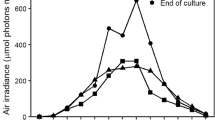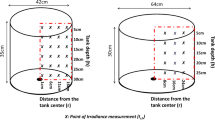Abstract
Numerous species of seaweed have been successfully cultivated in the sea for commercial purposes. Although considerable experimental work has been done on on-shore cultivation systems, none of these has yet proved to be economically viable on a sustained basis; nevertheless, such cultivation systems offer the potential for productivities greater than can be achieved in other systems. In on-shore systems, factors other than light can be controlled and provided at saturation levels. As density of biomass is controllable, all the light entering the cultivation system is absorbed. This results in efficient conversion of light energy to biomass when only light is limiting; moreover, density, rather than growth rate, is the major factor determining productivity. As growth of seaweeds in on-shore systems is only vegetative, there is no interruption for reproduction or maturation of the plants, and all of the net production can be recovered. Seaweeds have, though, relatively low percentage carbon composition, compared with terrestrial plants, and this may result in apparent high productivities based on dry matter.
Similar content being viewed by others
References
Bidwell, R. G. S., N. D. H. Lloyd & J. McLachlan, 1984. The performance of Chondrus crispus (Irish moss) in laboratory simulations of environments in different locations. Proc. int. Seaweed Symp. 11: 292–294.
Bidwell, R. G. S. & J. McLachlan, 1985. Carbon nutrition of seaweeds: photosynthesis, respiration and photorespiration. J. exp. mar. Biol. Ecol. 86: 15–46.
Bidwell, R. G. S., J. McLachlan & N. D. H. Lloyd, 1985. Tank cultivation of Irish moss, Chondrus crispus Stackh. Bot. mar. 28: 87–97.
Bugbee, B. G. & F. B. Salisbury, 1988. Exploring the limits of crop productivity. I. Photosynthetic efficiency of wheat in high irradiance environments. Pl. Physiol. 88: 869–878.
Campbell, J. W. & T. Aarup, 1989. Photosynthetically available radiation at high latitudes. Limnol. Oceanogr. 34: 1490–1499.
Charles-Edwards, D. A., D. Doley & G. M. Rimmington, 1986. Modelling Plant Growth and Development. Academic Press, New York, 235 pp.
Craigie, J. S., 1989. Irish moss cultivation: some reflections. In Yarish C., C. A. Penniman & P. van Patten (eds). Economically Important Plants of the Atlantic: Their Biology and Cultivation. Connecticut Sea Grant Program, Marine Science Institute, University of Connecticut, Groton CT, 37–52.
Craigie, J. S. & P. F. Shacklock, 1989. Culture of Irish moss. In Boghen A. D. (ed.). Cold-water Aquaculture in Atlantic Canada, The Canadian Institute of Research and Regional Development, Moncton NB, 243–270.
Deveau, L., 1989. cultivation of Chondrus crispus. XII'th Int. Seaweed Symp. Vancouver, BC. (Abstracts TB5).
Doty, M. S., 1987. The production and use of Eucheuma. In Doty M. S., J. F. Caddy & B. Santelices (eds). Case studies of seven commercial seaweed resources. FAO Technical Paper 281, Rome: 123–164.
Drew, K. M., 1949. Conchocelis—phase in the life history of Porphyra umbilicalis (L.) Kütz. Nature London 164: 748.
Enright, C. T. & J. S. Craigie, 1981. Effects of temperature and irradiance on growth and respiration of Chondrus crispus Stackh. Proc. int. Seaweed Symp. 10: 271–276.
Khailov, K. M. & YuG. Kamenir, 1988. Photoassimilation surface of plants and its correlation with the respiratory surface of animals in size rows. J. gen. Biol. 49: 844–853 (in Russian).
Khailov, K. M. & V. A. Silkin, 1986. Ecological classification of aquaculture bioproductive systems with respect to their aquaculture quality. J. gen. Biol. 47: 769–779 (in Russian).
Kirk, J. T. O., 1983. Light and Photosynthesis in Aquatic Ecosystems. Cambridge Univ. Press, Cambridge, 401 pp.
Littler, M. M. & D. S. Littler, 1980. The evolution of thallus form and survival strategies in benthic marine macroalgae: Field and laboratory tests of a functional form model. Am. Nat. 116: 25–44.
Lloyd, N. D. H., J. L. McLachlan & R. G. S. Bidwell, 1981. A rapid infra-red carbon-dioxide analysis screening technique for predicting growth and productivities of marine algae. Proc. int. Seaweed Symp. 10: 461–466.
McHugh, D. J. ed., 1987. Production and utilization of products from commercial seaweeds. FAO Tech. Paper 288, Rome 189 pp.
McHugh, D. J., 1991. Worldwide distribution of commercial resources of seaweeds including Gelidium. Hydrobiologia 221: 19–29.
McLachlan, J., 1973. Growth media-marine. In Stein J. R. (ed). Handbook of Phycological Methods: Culture Methods and Growth Measurements. Cambridge Univ. Press, Cambridge: 25–51.
McLachlan, J., 1985. Microalgae (seeweeds): industrial resources and their utilization. Plant & Soil 89: 137–157.
McLachlan, J., R. G. S. Bidwell, R. G. Smith & C. M. Moseley, 1986. Cultivation strategies for seaweeds. In Westermeir R. (ed.) Actas II Congr. Nacional sobre Algas Marinas Chilenas. Univ. Austral de Chile, Valdivia, Chile, 47–62.
Morgan, J. M., 1984. Modelling environmental effects on crop productivity. In Pearson C. J. (ed.) Control of crop productivity. Academic Press, New York: 289–304.
Moss, J. M., 1978. Essential considerations for establishing seaweed extraction factories. In Krauss R. W. (ed.). The Marine Plant Biomass of the Pacific Northwest Coast. Oregon State Univ. Press, Corvallis, OR: 301–314.
Nielsen, S. L. & K. Sand-Jensen, 1990. Allometric scaling of maximal photosynthetic growth rate to surface/volume ratio. Limnol. Oceanogr. 35: 177–181.
Neish, A. C., P. F. Shacklock, C. H. Fox & D. R. Robson, 1978. The cultivation of Chondrus crispus. Factors affecting growth under greenhouse conditions. Can. J. Bot. 55: 2263–2271.
Ryther, J. H., J. A. DeBoer & B. E. Lapointe, 1979. Cultivation of seaweeds of hydrocolloids, waste treatment and biomass for energy. Proc. int. Seaweed Symp. 9: 1–16.
Santelices, B. & R. Ugarte, 1990. Ecological differences among Chilean populations of commercial Gracilaria. J. appl. Phycol. 2: 17–26.
Schreiber, 1927. Die Reinkultur von marinen Phytoplankton und deren Bedeutung für die Erforschung de Produktionsfähigkeit des Meerwassers. Wiss. Meeresuntersuch. N.F. 16: 1–34.
Thornley, J. H. M., 1990. A new formulation of the logistic growth equation and its application to leaf area growth. Ann. Bot. 66: 309–311.
Wheeler, W. N. 1988. Algal productivity and hydrodynamics — a synthesis. Progr. Phycol. Res. 6: 23–58.
Woodward, J. N., 1952. Forward. Proc. int. Seaweed Symp. 1: iv.
Author information
Authors and Affiliations
Rights and permissions
About this article
Cite this article
McLachlan, J.L. General principles of on-shore cultivation of seaweeds: effects of light on production. Hydrobiologia 221, 125–135 (1991). https://doi.org/10.1007/BF00028369
Issue Date:
DOI: https://doi.org/10.1007/BF00028369




